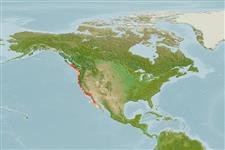Environment: milieu / climate zone / depth range / distribution range
Ecologia
marinhas; estuarina demersal; intervalo de profundidade 0 - 425 m (Ref. 6793). Temperate; 52°N - 24°N, 131°W - 110°W
Eastern Pacific: Queen Charlotte Sound, British Columbia, Canada to Magdalena Bay, Baja California Sur, Mexico.
Length at first maturity / Tamanho / Peso / Idade
Maturity: Lm 32.0, range 29 - 39 cm
Max length : 56.0 cm TL macho/indeterminado; (Ref. 2850); peso máx. Publicado: 1.5 kg (Ref. 40637); Idade máx. registada: 35 anos (Ref. 56049)
Espinhos dorsais (total): 13; Raios dorsais moles (total): 13-16; Espinhos anais 3; Raios anais moles: 7 - 9; Vértebras: 26. Head spines very weak - preoculars present, nasal, supraocular and parietal spines usually absent, postocular, tympanic, coronal and nuchal spines absent; chin projects outward; preopercular spines fairly strong; anal fin small and rear edge slanted posteriorly, 2nd anal spine short; body slender (Ref. 27437). Caudal fin moderately indented (Ref. 6885). Pinkish red to copper pink, white ventrally; lateral line in bright red zone; caudal fin dusky (Ref. 27437).
Adults frequent deep rocky reefs as well as sand and mud bottoms; young are pelagic (Ref. 36715) and occur in shallower waters (Ref. 2850). Feed on euphausiids (Ref. 6885), krill, small squids and fishes (Ref. 2850). Viviparous, with planktonic larvae (Ref. 36715). Marketed fresh and frozen; eaten fried, boiled, microwaved and baked (Ref. 9988).
Eschmeyer, W.N., E.S. Herald and H. Hammann, 1983. A field guide to Pacific coast fishes of North America. Boston (MA, USA): Houghton Mifflin Company. xii+336 p. (Ref. 2850)
Categoria na Lista Vermelha da IUCN (Ref. 130435)
Ameaça para o homem
Harmless
Utilização humana
Pescarias: espécies comerciais; peixe desportivo: sim
Mais informação
ReferênciasAquaculturaPerfil para aquaculturaEstirpesGenéticaElectrophoresesHereditariedadeDoençasProcessamentoNutrientsMass conversion
ColaboradoresFotografiasStamps, Coins Misc.SonsCiguateraVelocidadeTipo de nataçãoÁrea branquialOutras referênciasCérebrosVisão
Ferramentas
Relatórios especiais
Descarregue XML
Fontes da internet
Estimates based on models
Preferred temperature (Ref.
123201): 7 - 9.7, mean 8.2 °C (based on 39 cells).
Phylogenetic diversity index (Ref.
82804): PD
50 = 0.5000 [Uniqueness, from 0.5 = low to 2.0 = high].
Bayesian length-weight: a=0.01000 (0.00499 - 0.02004), b=3.09 (2.92 - 3.26), in cm total length, based on LWR estimates for this Genus-body shape (Ref.
93245).
Nível Trófico (Ref.
69278): 3.5 ±0.44 se; based on food items.
Resiliência (Ref.
120179): Médio, tempo mínimo de duplicação da população 1,4 - 4,4 anos (K=0.24; tm=4; tmax=27; Fec=29,000).
Fishing Vulnerability (Ref.
59153): Moderate to high vulnerability (52 of 100).
Climate Vulnerability (Ref.
125649): Low to moderate vulnerability (27 of 100).
Nutrients (Ref.
124155): Calcium = 23.4 [8.5, 73.8] mg/100g; Iron = 0.242 [0.103, 0.603] mg/100g; Protein = 18.2 [16.9, 19.4] %; Omega3 = 1.34 [0.55, 3.24] g/100g; Selenium = 40.2 [14.5, 117.3] μg/100g; VitaminA = 18.4 [7.4, 48.4] μg/100g; Zinc = 0.429 [0.226, 0.756] mg/100g (wet weight);
